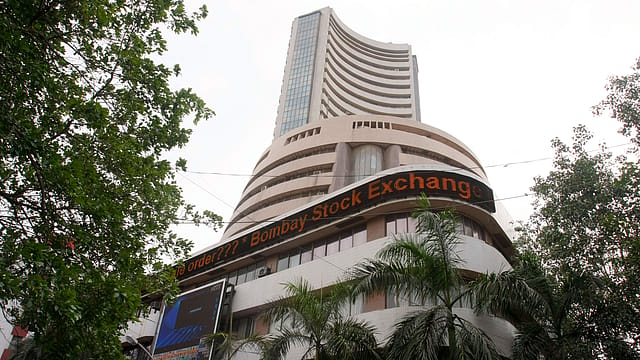BLOODBATH ON D-STREET
ADVERTISEMENT

For equity market participants, circuit breakers being triggered for indices are not routine occurrences. Those on the benchmark indices are rare. And two such lower circuits, on the S&P BSE Sensex as well as the Nifty 50, triggering the second trading halt of 45 minutes within two weeks is even rarer.
It was in early trade on March 13 when the markets crashed 10%, hitting the lower circuit, and halting trading temporarily. Today, again in early trade, the markets tanked 10% to trigger another trading pause. However, March 13 saw a sharp U-turn in recovery as the benchmark indices gained 16% each after the fall to end up 4% higher.
But the Coronavirus scare on March 23 seems to be way more chronic, as both the indices—the Sensex and Nifty 50—registered new 52-week lows practically every few minutes.
And at the day’s low of 25,981.24 points and 7,583.6 points, the Sensex and Nifty 50 had lost over 4,035 points and 1,161 points from their Friday’s close of 29,915.96 points and 8,745.45 points, respectively; in percentage terms the indices saw a decline of 13.49% and 13.29%, respectively. From their lifetime-highs clinched on January 20, the plunge was 16,393 points (-38.78%) for the Sensex and 4,846 points (-38.99%) for the Nifty 50.
December 2025
The annual Fortune 500 India list, the definitive compendium of corporate performance, is out. This year, the cumulative revenue of the Fortune 500 India companies has breached $2 trillion for the first time. Plus, find out which are the Best B-schools in India.
At the end of Monday’s trade, the Sensex and Nifty 50 lost 3,934.72 points (-13.15%) and 1,135.2 points (-12.98%) to close at 25,981.24 points and 7,610.25 points, respectively. These declines at close broke the previous such records of both the benchmark indices, which were set as recently as March 9, when the respective indices lost 1,941.67 points and 538 points at the close.
Earlier both the indices had recorded their biggest decline on January 21, 2008—during the peak of the global financial meltdown—when the Sensex closed down 1,408.35 points and the Nifty 50 closed 496.5 points lower than the previous day’s close.
The decline in the S&P BSE MidCap and SmallCap also mirrored the broader benchmark indices, with a respective fall of 13.02% and 12.39% at the day’s (and also the new 52-week) low from Friday’s close. At the close of trade on Monday, the mid-cap and small-cap indices had lost 1,429 points (-12.83%) and 1,240 points (-12.27%), respectively, from their previous day’s close.
In the case of the mid-cap and small-cap indices, the difference between the 52-week high and low is relatively higher. Compared to its 52-week high of 15,930.78 points on February 12, the mid-cap index has corrected over 6,239 points (-39.17%) at today’s 52-week low of 9,690.86 points. Similarly, at today’s 52-week low, the small-cap index has seen a reduction of 6,369 points (-41.82%) from its 52-week high of 15,229.85 recorded on April 1, 2019.
According to S. Ranganathan, head of research at LKP Securities, the coronavirus interplay with health and markets brought Dalal Street to its knees today, as foreign investors raised cash across emerging markets. “The Covid-19 proved to be a three-in-1 shock across demand, supply, and markets as lockdowns and quarantines weighed heavily on financial markets,” says Ranganathan.
Clearly, the volatility-curtailing measures announced by markets regulator Securities and Exchange Board of India (SEBI) late Friday evening seem to be working in a very concentrated manner.
And India’s economic situation, which was already fragile, will also take a beating. According to Tanvee Gupta Jain, economist at UBS Securities India, the country’s real GDP (gross domestic product) growth will slow at an annual 4% in FY21 (5.1% projected earlier) from the 4.8% estimated for FY20.
“The challenge for India versus its peers is starker if infections spread rapidly considering the higher density of population, per capita [income], and weaker health infrastructure,” she warns.
On similar lines, Gupta’s colleague Rohit Arora, strategist with UBS Securities India, says that the possible multi-week shutdown (closure of shopping malls, movie halls, clubs, etc., have already been announced in various states) to slow the spread of Covid-19 will entail a near-term economic cost. “Consumption will likely remain weaker for longer and possible job losses mean the recovery will be delayed,” Arora explains.
With confirmed cases of coronavirus touching 415 as on March 23, the scare of the pandemic taking explosive shape in India is giving jitters to the bulls and the bears are getting an even stronger grip on the market.
Meanwhile, the Reserve Bank of India (RBI) announced that it would conduct variable rate term repo auctions of ₹1 lakh crore as a pre-emptive measure to tide over any frictional liquidity requirements on account of dislocations due to Covid-19. The RBI said that it decided to conduct the fine-tuning variable rate repo auctions in two tranches of ₹50,000 crore each; first on Monday and the other on Tuesday, for a period of 16 days.
In its release announcing the auctions, the central bank said that it was monitoring the evolving financial market conditions. “The Reserve Bank will calibrate its operations to meet any need for additional liquidity support, if warranted, to ensure normal functioning of the markets, promote staff welfare, and preserve financial stability,” the RBI assured.
Reacting to the RBI’s move, Rahul Gupta, head of research–currency at Emkay Global Financial Services, said instead of a repo rate cut, the central bank is taking these unconventional measures or alternative mechanism to infuse liquidity into the system to support the economy. “A rate cut of at least 50 basis points still remains on cards, which can take place during the RBI’s next monetary policy meeting on April 3,” Gupta said.
